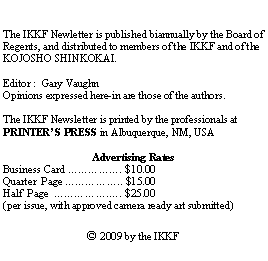

|
THE IKKF BOARD OF REGENTS |

|
TRADITIONAL KARATE
Webster defines a tradition as something that is handed down from generation to generation. The definition doesn't require that this transmission must be absolutely unchanged or that nothing should ever be added or taken away, however the consensus is that if something is ìtraditionalî, then what is being handed down is a long-established custom or practice ìthat has the effect of an unwritten law. Traditional teachings are expected to conform to tradition. The possibility for change is ever present, especially in Karate. When we compare early Okinawa Karate to the art not only as currently practiced in Japan but worldwide, the differences are obvious. Just a glance at contemporary Karate in the U.S.A. is proof that even in traditional schools change is inevitable - though not necessarily always desirable. What has been consistent in traditional Karate/Kempo schools is the placement of personal development, discipline and fitness before self-defense. Respect and courtesy are forever emphasized. The workout area is typically simple and clean, an air of seriousness and purpose prevail, the practice uniform is always clean and free of unnecessary decoration, and bright or outlandish colors are avoided. The traditional method of teacher demonstrating and students copying continues to be the vehicle by which old information is transferred to new students. Of course, all of the above are mere words unless the teachers and the students strive to be better members of society, and always use their self-defense skills for honorable purposes. Today's traditional Karate/Kempo school has seen many changes since its humble beginnings as a place to study the art of self defense in Okinawa. There has been the divergent path and subsequent growth of classical Japanese Karate Do into a sport / art. There has been the emergence of Korean Karate and the birth of Tae Kwon Do as a national sport of Korea. There has been the Hawaii experience and the birth of Kenpo and ultimately the birth of American Karate. However, much of our tradition remains the same. Perhaps we should try to concentrate on the similarities instead of the differences. F. Absher |
|
Art Minser Monkey |
Richard Levin Leopard |
|
Larry Bennett Dragon (d) |
Gary Vaughn Deer |
|
Toby Gordon Tiger |
Terry Gearey Bear |
|
Dona Absher Crane/Lake |
Jack Diehl Deer/Heaven |
|
Steve Goldsmith Monkey/Fire |
Peter Renna Deer/Mountain |
|
|
|
|
Shane Absher |
Benny Bird |
|
Howard Cothern |
Linda Dominguez |
|
Mike Grijalva |
David Higgins |
|
Joseph Paranto |
Mike Pierson |
|
Al Reed |
Rudy Rivera (d) |
|
Charles Sheldon |
Ron Striegel |
|
Victor Velarde |
Marian Macy Zajac |
|
Frank Zajac |
|